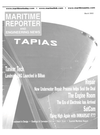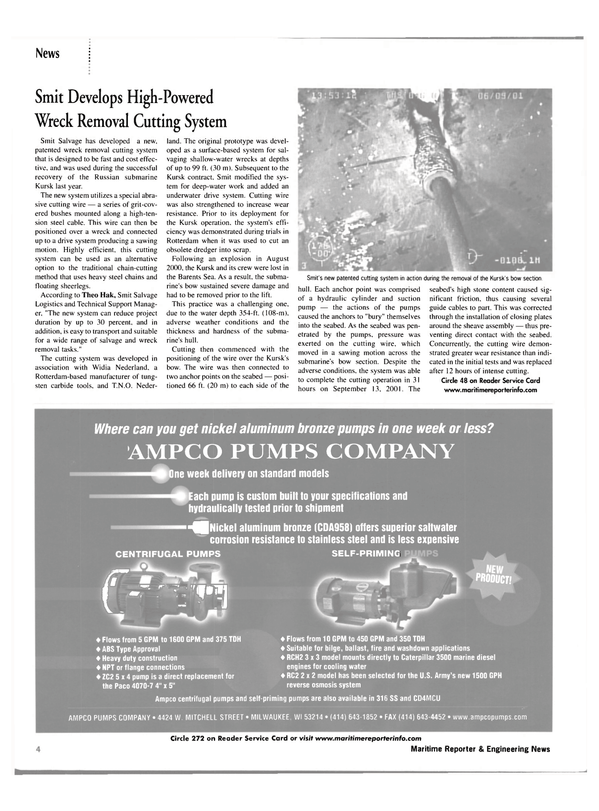
Smit Develops High-Powered Wreck Removal Cutting System
Smit Salvage has developed a new.
patented wreck removal cutting system that is designed to be fast and cost effective, and was used during the successful recovery of the Russian submarine Kursk last year.
The new system utilizes a special abrasive cutting wire — a series of grit-covered bushes mounted along a high-tension steel cable. This wire can then be positioned over a wreck and connected up to a drive system producing a sawing motion. Highly efficient, this cutting system can be used as an alternative option to the traditional chain-cutting method that uses heavy steel chains and floating sheerlegs.
According to Theo Hak, Smit Salvage Logistics and Technical Support Manager, "The new system can reduce project duration by up to 30 percent, and in addition, is easy to transport and suitable for a wide range of salvage and wreck removal tasks." The cutting system was developed in association with Widia Nederland. a Rotterdam-based manufacturer of tungsten carbide tools, and T.N.O. Nederland.
The original prototype was developed as a surface-based system for salvaging shallow-water wrecks at depths of up to 99 ft. (30 m). Subsequent to the Kursk contract, Smit modified the system for deep-water work and added an underwater drive system. Cutting wire was also strengthened to increase wear resistance. Prior to its deployment for the Kursk operation, the system's efficiency was demonstrated during trials in Rotterdam when it was used to cut an obsolete dredger into scrap.
Following an explosion in August 2000, the Kursk and its crew were lost in the Barents Sea. As a result, the submarine's bow sustained severe damage and had to be removed prior to the lift.
This practice was a challenging one, due to the water depth 354-ft. (108-m), adverse weather conditions and the thickness and hardness of the submarine's hull.
Cutting then commenced with the positioning of the wire over the Kursk's bow. The wire was then connected to two anchor points on the seabed — positioned 66 ft. (20 m) to each side of the hull. Each anchor point was comprised of a hydraulic cylinder and suction pump — the actions of the pumps caused the anchors to "bury" themselves into the seabed. As the seabed was penetrated by the pumps, pressure was exerted on the cutting wire, which moved in a sawing motion across the submarine's bow section. Despite the adverse conditions, the system was able to complete the cutting operation in 31 hours on September 13, 2001. The seabed's high stone content caused significant friction, thus causing several guide cables to part. This was corrected through the installation of closing plates around the sheave assembly — thus preventing direct contact with the seabed.
Concurrently, the cutting wire demonstrated greater wear resistance than indicated in the initial tests and was replaced after 12 hours of intense cutting.
Circle 4 8 on Reader Service Card www.maritimereporterinfo.com
Read Smit Develops High-Powered Wreck Removal Cutting System in Pdf, Flash or Html5 edition of March 2002 Maritime Reporter
Other stories from March 2002 issue
Content
- Smit Develops High-Powered Wreck Removal Cutting System page: 4
- KMY To Consult on Icebreaker page: 8
- Bollinger To Build Three Boats for Chouest page: 9
- IFS And DNV Join Forces On IT Project page: 12
- Volvo Penta Signs $ 2 . 8M Tug Engine Contract page: 14
- Underwater Bonding Seals the Deal page: 17
- Grand Bahama Shipyard's Drydock Arrives page: 19
- One Cool Customer page: 21
- ReeferShip Ltd. Formed page: 23
- A.R. Larsen To Offer Turnkey Interior Services page: 23
- The Era of The Electronic Engine Is Here page: 24
- Rolls-Royce Package Approach Wins Order page: 25
- Innovation in the Engine Space page: 27
- Landmark LNG Carrier Launched by IZAR page: 28
- BY backs S&T Ecomax Tanker Design page: 31
- Maritrans Continues Double Hull Program page: 32
- French Snag LNG Order page: 32
- LR: Hearing is Believing page: 32
- Antifouling Paint Helps USCG Sink Maintenance Costs page: 36
- NSRP Projects Show Impressive Results page: 38
- Derecktor Wins AMHS Fast Ferry Deal page: 41
- Gas Turbines Continue Making Commercial Inroads page: 44
- Fleet F77 Extends Inmarsat's Offering s page: 46
- Spain: Finding Strength in Specialization page: 51


